Abstract
Variants of human immunodeficiency virus (HIV) with reduced sensitivity to zidovudine (3'-azido-3'-deoxythymidine) have been selected by passage of virus in cell culture in the presence of drug. Wild-type, sensitive virus became partially resistant to zidovudine by passage 12 (50% inhibitory dose values measured in HeLa CD4+ cells increased from 0.014 to 0.2 microM), and genetic analysis using the polymerase chain reaction revealed that mutations in the reverse transcriptase coding region identical to those seen in clinical isolates from treated individuals had occurred. The order of appearance of these resistance mutations in passaged virus was also similar to that in clinical isolates. The partially resistant strain, HIVRTMC/F, became highly zidovudine resistant by passage 12 (50% inhibitory dose values increased from 0.4 to 2.5 microM during passages 7 to 11). Nucleotide sequence analysis of the reverse transcriptase from this variant revealed a novel amino acid substitution (Lys----Glu) at codon 219. A different substitution at this codon (Lys----Gln) had been seen previously in clinical isolates. When this mutation was created in HIVRTMC/F by site-directed mutagenesis, the resulting partially resistant virus became highly resistant, thus confirming the significance of this change. In view of the possibility that this mutation might occur in HIV isolates during treatment of patients, we adapted our selective polymerase chain reaction procedure to enable screening for this change in clinical samples. The virus passage procedure described here may be useful for gaining further insight into the mutational events occurring during the development of resistance to zidovudine and other HIV inhibitors.
Full text
PDF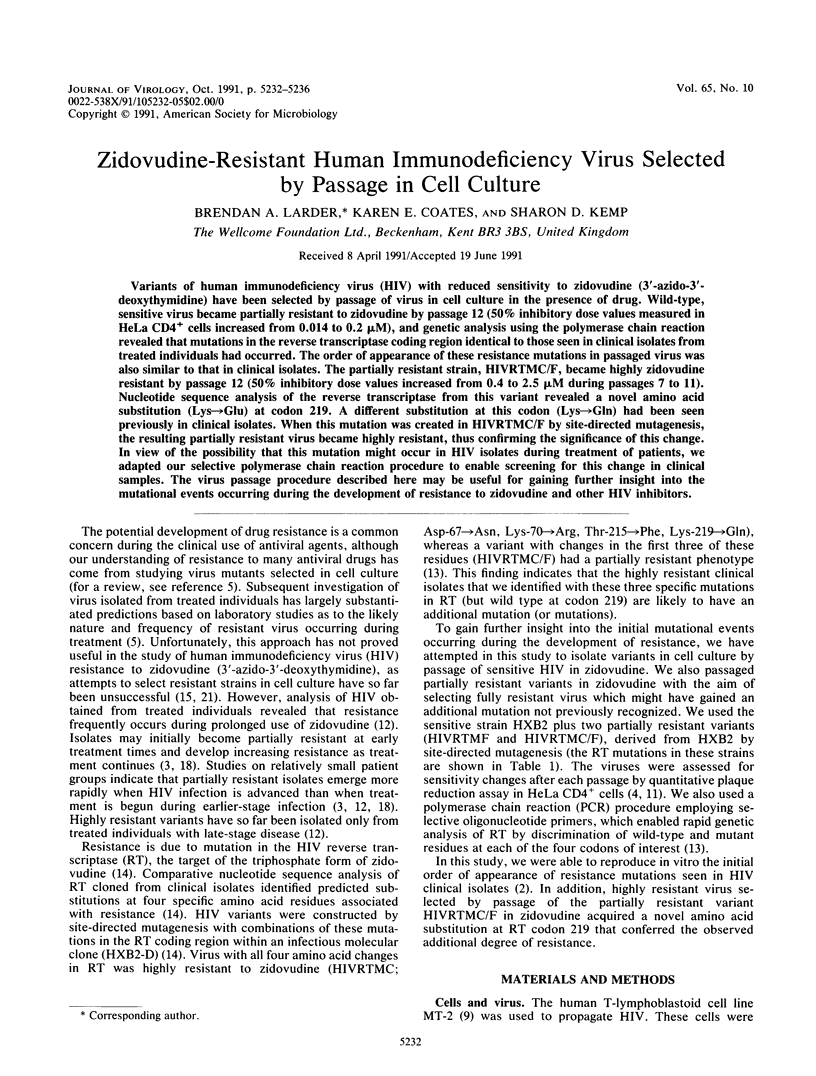
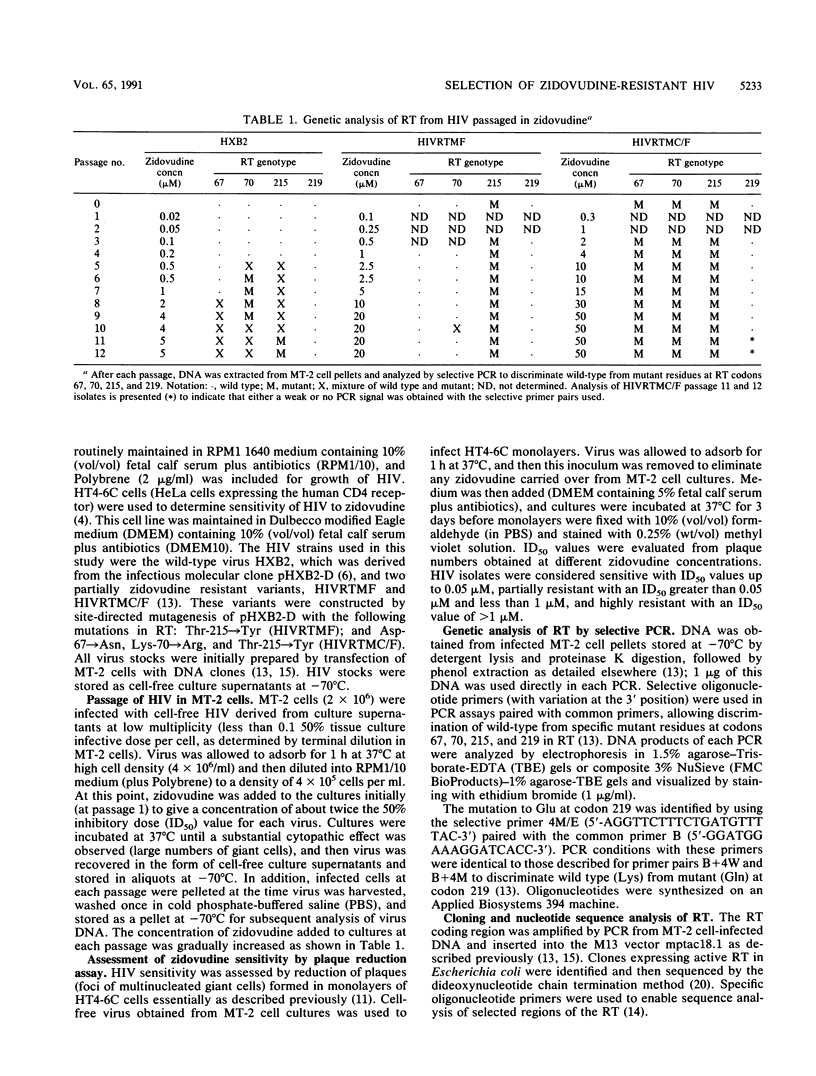
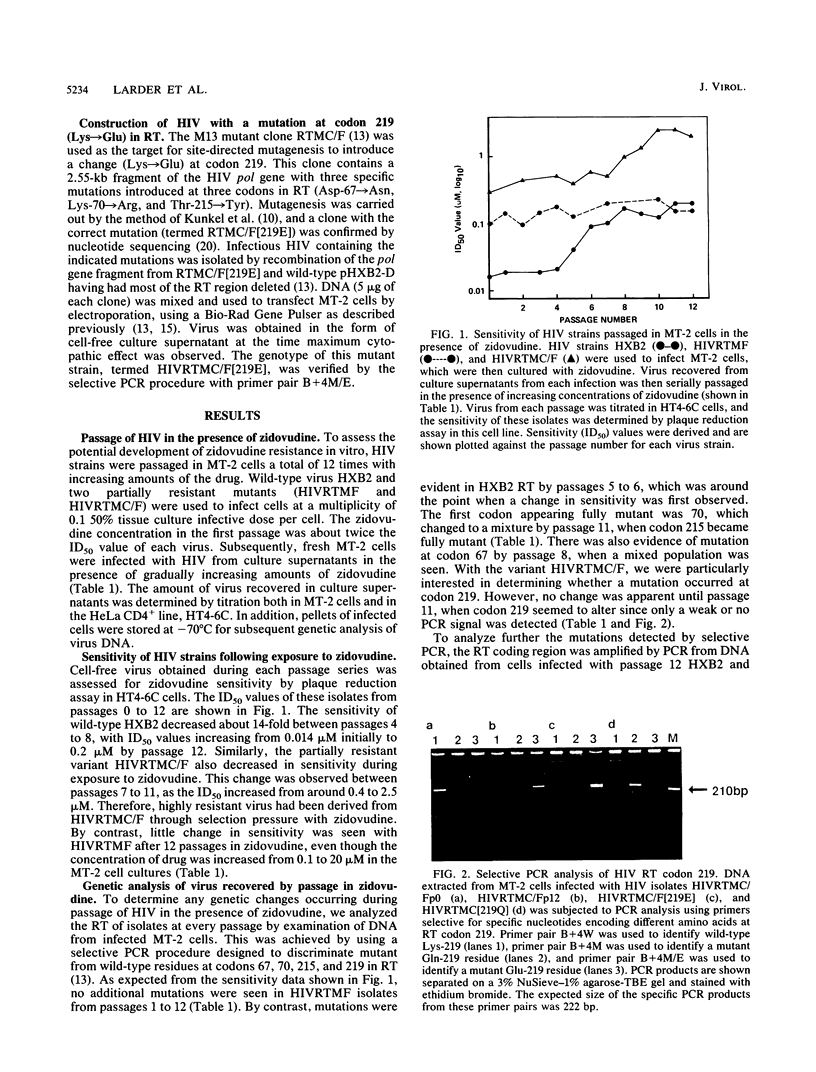
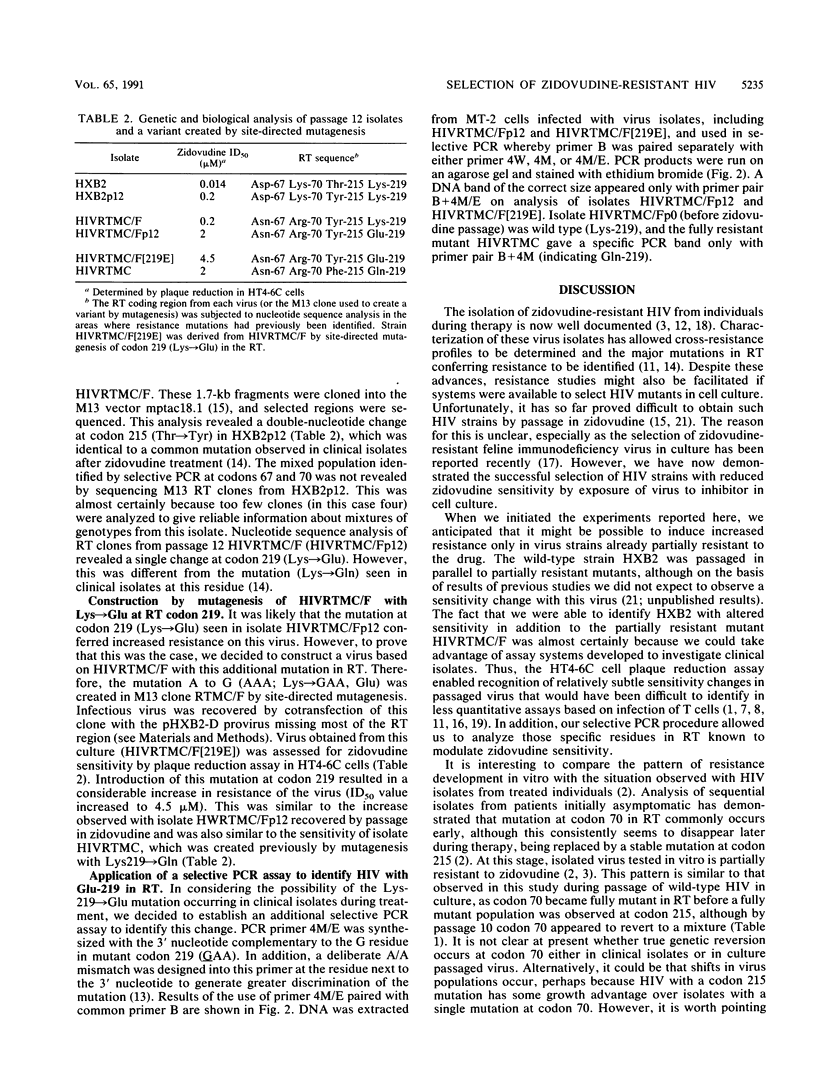
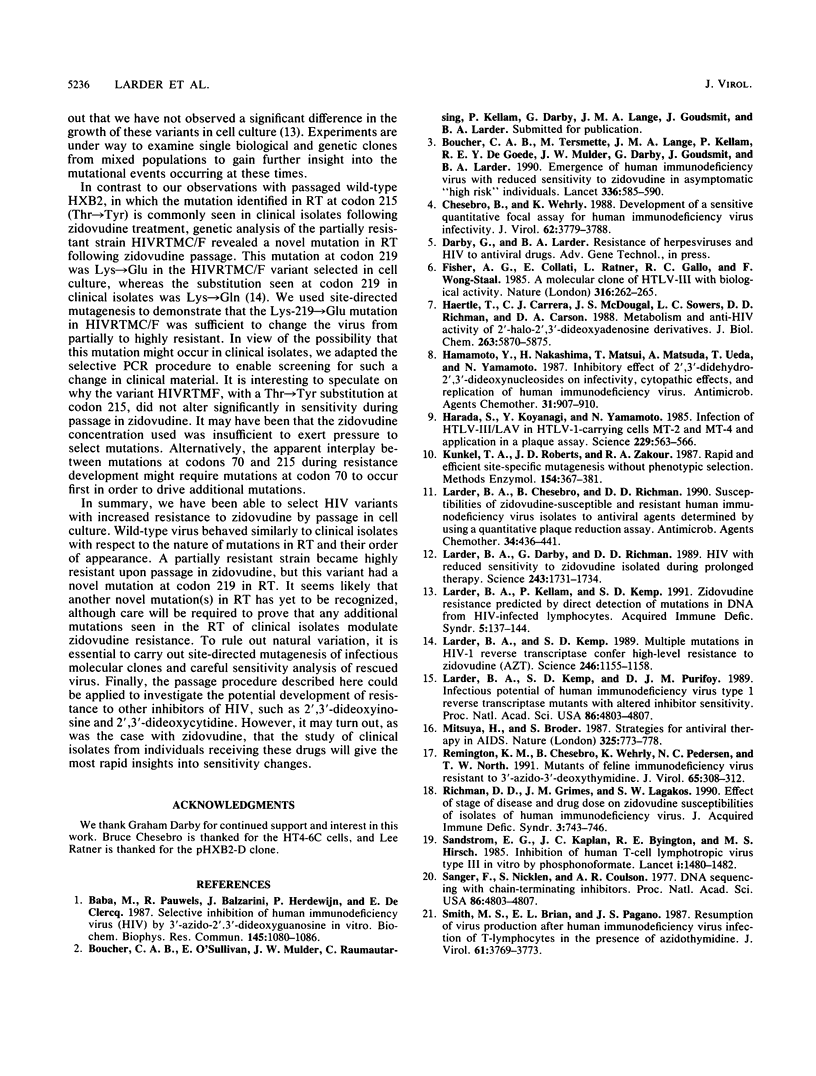
Images in this article
Selected References
These references are in PubMed. This may not be the complete list of references from this article.
- Baba M., Pauwels R., Balzarini J., Herdewijn P., De Clercq E. Selective inhibition of human immunodeficiency virus (HIV) by 3'-azido-2', 3'-dideoxyguanosine in vitro. Biochem Biophys Res Commun. 1987 Jun 30;145(3):1080–1086. doi: 10.1016/0006-291x(87)91547-6. [DOI] [PubMed] [Google Scholar]
- Boucher C. A., Tersmette M., Lange J. M., Kellam P., de Goede R. E., Mulder J. W., Darby G., Goudsmit J., Larder B. A. Zidovudine sensitivity of human immunodeficiency viruses from high-risk, symptom-free individuals during therapy. Lancet. 1990 Sep 8;336(8715):585–590. doi: 10.1016/0140-6736(90)93391-2. [DOI] [PubMed] [Google Scholar]
- Chesebro B., Wehrly K. Development of a sensitive quantitative focal assay for human immunodeficiency virus infectivity. J Virol. 1988 Oct;62(10):3779–3788. doi: 10.1128/jvi.62.10.3779-3788.1988. [DOI] [PMC free article] [PubMed] [Google Scholar]
- Fisher A. G., Collalti E., Ratner L., Gallo R. C., Wong-Staal F. A molecular clone of HTLV-III with biological activity. Nature. 1985 Jul 18;316(6025):262–265. doi: 10.1038/316262a0. [DOI] [PubMed] [Google Scholar]
- Haertle T., Carrera C. J., Wasson D. B., Sowers L. C., Richman D. D., Carson D. A. Metabolism and anti-human immunodeficiency virus-1 activity of 2-halo-2',3'-dideoxyadenosine derivatives. J Biol Chem. 1988 Apr 25;263(12):5870–5875. [PubMed] [Google Scholar]
- Hamamoto Y., Nakashima H., Matsui T., Matsuda A., Ueda T., Yamamoto N. Inhibitory effect of 2',3'-didehydro-2',3'-dideoxynucleosides on infectivity, cytopathic effects, and replication of human immunodeficiency virus. Antimicrob Agents Chemother. 1987 Jun;31(6):907–910. doi: 10.1128/aac.31.6.907. [DOI] [PMC free article] [PubMed] [Google Scholar]
- Harada S., Koyanagi Y., Yamamoto N. Infection of HTLV-III/LAV in HTLV-I-carrying cells MT-2 and MT-4 and application in a plaque assay. Science. 1985 Aug 9;229(4713):563–566. doi: 10.1126/science.2992081. [DOI] [PubMed] [Google Scholar]
- Kunkel T. A., Roberts J. D., Zakour R. A. Rapid and efficient site-specific mutagenesis without phenotypic selection. Methods Enzymol. 1987;154:367–382. doi: 10.1016/0076-6879(87)54085-x. [DOI] [PubMed] [Google Scholar]
- Larder B. A., Chesebro B., Richman D. D. Susceptibilities of zidovudine-susceptible and -resistant human immunodeficiency virus isolates to antiviral agents determined by using a quantitative plaque reduction assay. Antimicrob Agents Chemother. 1990 Mar;34(3):436–441. doi: 10.1128/aac.34.3.436. [DOI] [PMC free article] [PubMed] [Google Scholar]
- Larder B. A., Darby G., Richman D. D. HIV with reduced sensitivity to zidovudine (AZT) isolated during prolonged therapy. Science. 1989 Mar 31;243(4899):1731–1734. doi: 10.1126/science.2467383. [DOI] [PubMed] [Google Scholar]
- Larder B. A., Kellam P., Kemp S. D. Zidovudine resistance predicted by direct detection of mutations in DNA from HIV-infected lymphocytes. AIDS. 1991 Feb;5(2):137–144. doi: 10.1097/00002030-199102000-00002. [DOI] [PubMed] [Google Scholar]
- Larder B. A., Kemp S. D. Multiple mutations in HIV-1 reverse transcriptase confer high-level resistance to zidovudine (AZT). Science. 1989 Dec 1;246(4934):1155–1158. doi: 10.1126/science.2479983. [DOI] [PubMed] [Google Scholar]
- Larder B. A., Kemp S. D., Purifoy D. J. Infectious potential of human immunodeficiency virus type 1 reverse transcriptase mutants with altered inhibitor sensitivity. Proc Natl Acad Sci U S A. 1989 Jul;86(13):4803–4807. doi: 10.1073/pnas.86.13.4803. [DOI] [PMC free article] [PubMed] [Google Scholar]
- Mitsuya H., Broder S. Strategies for antiviral therapy in AIDS. 1987 Feb 26-Mar 4Nature. 325(6107):773–778. doi: 10.1038/325773a0. [DOI] [PubMed] [Google Scholar]
- Remington K. M., Chesebro B., Wehrly K., Pedersen N. C., North T. W. Mutants of feline immunodeficiency virus resistant to 3'-azido-3'-deoxythymidine. J Virol. 1991 Jan;65(1):308–312. doi: 10.1128/jvi.65.1.308-312.1991. [DOI] [PMC free article] [PubMed] [Google Scholar]
- Richman D. D., Grimes J. M., Lagakos S. W. Effect of stage of disease and drug dose on zidovudine susceptibilities of isolates of human immunodeficiency virus. J Acquir Immune Defic Syndr. 1990;3(8):743–746. [PubMed] [Google Scholar]
- Sandstrom E. G., Kaplan J. C., Byington R. E., Hirsch M. S. Inhibition of human T-cell lymphotropic virus type III in vitro by phosphonoformate. Lancet. 1985 Jun 29;1(8444):1480–1482. doi: 10.1016/s0140-6736(85)92255-x. [DOI] [PubMed] [Google Scholar]
- Smith M. S., Brian E. L., Pagano J. S. Resumption of virus production after human immunodeficiency virus infection of T lymphocytes in the presence of azidothymidine. J Virol. 1987 Dec;61(12):3769–3773. doi: 10.1128/jvi.61.12.3769-3773.1987. [DOI] [PMC free article] [PubMed] [Google Scholar]



